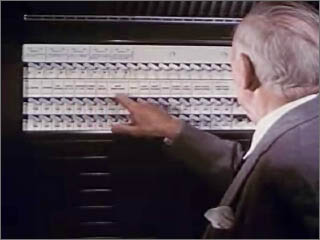 |  | Courtesy: Prelinger Archives |
Voting problems are nothing new. More than 100 years before Florida's election controversy, American democracy was in crisis, brought on by rampant ballot stuffing, vote buying and other electoral shenanigans. The era was epitomized by men like William Boss Tweed, a Democratic party kingpin in New York City. Tweed is reputed to have said it wasn't voters who determined elections, but those who counted the votes. But at the close of the 19th century, a technological innovation promised a solution to voter fraud. A clip from a 1957 promotional film describes the new machinery.
"Mr. Citizen moves the operating lever to the right. Which unlocks the machine and locks out the world. For the first time the secret ballot is really secret. His vote is made and cast untouched by other human hands or minds and that's a long step up from tyranny."
Mechanical lever machines, first patented by Thomas Edison, promised absolute security and accuracy by using interlocked rotary counters instead of paper. By the 1950s, nearly half of America's voters were using lever machines.
Only a decade later, the computer revolution led to the use of punch cards, a seeming resurgence of the paper ballot. But the 2000 presidential election exposed serious problems with punch cards. As a result, America is on the verge of another voting revolution.
Sleek, fully electronic machines with color consoles similar to bank ATMs are spreading across America. Manufacturers claim the machines offer near-perfect accuracy and many election officials are enthusiastic about their results so far; but there have been problems. When touch screens debuted in Florida in 2002, elections in the state's two biggest counties were thrown into chaos.
An investigation by Miami's inspector general concluded the elections were a debacle. Poorly trained poll workers and malfunctioning machines led to long delays in calculating final results in Miami-Dade and Broward counties. While the results in those two counties were not contested, there were challenges in other counties. In Palm Beach County, home of the infamous butterfly ballot in 2000, officials tried to play it safe and test the new machines in seemingly low-stakes municipal races.
As the polls began to close on an early spring day, complaints started rolling in to the office of Charlotte Danciu, an attorney in the wealthy, beachfront community of Boca Raton. Danciu's father, Emil, was a Republican former mayor competing in a four-person race for two slots on the city council.
"They were touching the screen and it was coming up somebody else's name," describes Danciu. "The poll workers were doing things like pulling the plug out of the machine and they were kicking the machine. And then, because there's no receipt, people were saying, 'I don't know what my vote recorded as.'"
Emil Danciu lost the council race, even in his home district. The Dancius suspected malfunctioning touch screens mistakenly gave votes to Danciu's competitors. So the Dancius filed a lawsuit and they hired Rebecca Mercuri, a computer scientist and university professor who is an outspoken critic of electronic voting machines.
"The problem," explains Mercuri, "is that when the vote goes in, it's all invisible. It just gets converted into electrons. There's no physical thing. You can't open up the box and see that you're vote went from the thing you touched on the screen and is now recorded in the cartridge."
With Rebecca Mercuri at their side, the Dancius toured the storage facility that houses Palm Beach County's touch-screen machines. Mercuri suspected faulty computer software, and wanted to take a look inside the machines. She was most interested in looking at the computers' source code, which is a unique set of programing instructions created by the manufacturer.
Walking around inside the warehouse, Mercuri explains, "We were told again and again that all of these are protected by trade secrets. They are not required to reveal them unless a court authorizes that."
Next: TOP SECRET SOFTWARE
| 
